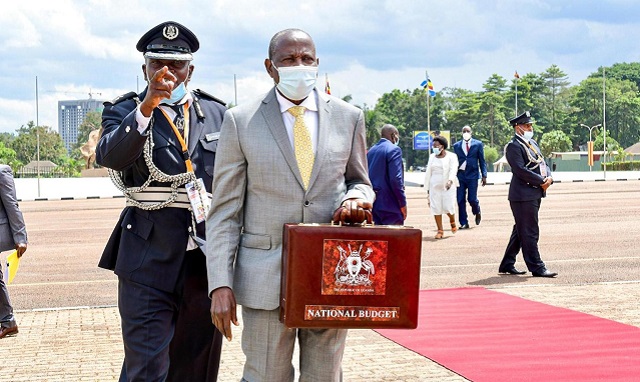
The country’s public debt now stands at Shs 93.6 trillion as of June 2024, with 27.4% of domestic revenue earmarked for interest payments
Kampala, Uganda | JULIUS BUSINGE | Uganda’s rising debt burden has come under renewed scrutiny as the government prepares the FY2025/26 national budget, projected at Shs 57.4 trillion—significantly lower than the current Shs 72.1 trillion budget. The Civil Society Budget Advocacy Group (CSBAG) has called for urgent fiscal discipline, warning that unchecked borrowing could strain economic stability.
The country’s public debt now stands at Shs 93.6 trillion as of June 2024, with 27.4% of domestic revenue earmarked for interest payments. CSBAG cautions that this trend limits Uganda’s ability to finance key sectors such as healthcare, education, and infrastructure.
“The government must ensure that borrowed funds are directed towards productive sectors that yield long-term economic benefits,” said Julius Mukunda, executive director of CSBAG, during a budget dialogue in Kampala on Feb. 13.
Domestic vs project support
The FY2025/26 budget is expected to be financed through domestic revenue (58.6%, or Shs 33.68 trillion), project support (22.3%, or Shs 12.81 trillion), and borrowing (40.9%, or Shs 23.47 trillion). While the government has made efforts to reduce reliance on external funding, CSBAG warns that debt repayment obligations are becoming unsustainable.
Beyond debt concerns, CSBAG is advocating for realistic budgeting and efficient resource allocation to ensure inclusive growth. The organization highlights the need to prioritise productive sectors that can drive economic recovery and reduce reliance on borrowing.
The budget framework allocates funds across key sectors, but CSBAG urges the government to reconsider certain priorities to enhance economic resilience and social welfare.
With 30.1% of Ugandans living below the poverty line, investment in social protection is crucial. The budget proposes Shs 112.448 billion for elderly and disability support, Shs 80 million for gender-based violence response, and Shs 13.69 billion for youth livelihood support. However, CSBAG calls for increased allocations to these areas to create more impactful interventions that directly improve livelihoods.
While Shs 399.74 billion has been allocated to the Uganda Road Fund and Shs 181.81 billion for community access road maintenance, CSBAG urges the government to prioritize road networks in rural areas to improve market access for farmers. Increased investment in electricity connections (Shs 151.08 billion) is also commendable, but measures should be put in place to enhance efficiency in service delivery.
Despite the critical role of local governments in service delivery, only 10.7% of the budget is allocated to them. CSBAG stresses that this is inadequate and calls for a reallocation to ensure that essential services reach communities effectively.
However, several pressing challenges threaten the effectiveness of Uganda’s budget implementation, according to CSBAG.
The budget, for instance, has a Shs 10.4 trillion gap compared to the National Development Plan IV (NDP IV) target of Shs 67.8 trillion. This misalignment raises concerns about the feasibility of the country’s long-term economic objectives.
The Office of the Auditor General (OAG) has also highlighted persistent revenue losses, which, if addressed, could significantly improve budget performance.
In addition, the government arrears now stand at Shs 13.81 trillion, yet only Shs 200 billion has been allocated for clearance. At this rate, CSOs say, it will take over 50 years to clear existing arrears, worsening financial credibility.
Interestingly, in FY2023/24, Shs 1.492 trillion of approved funds remained unutilized due to inefficiencies, demonstrating a need for improved public investment management.
The frequent use of supplementary budgets outside normal planning undermines fiscal discipline and transparency. CSBAG urges strict adherence to approved allocations.
To ensure a more sustainable and inclusive budget, CSBAG recommends strict measures to curb excessive borrowing and unproductive expenditure, alignment with NDP IV, reducing cost overruns, and ensuring that all allocated funds are absorbed effectively.
“Citizen engagement is key to holding leaders accountable and advocating for budget transparency and efficiency,” Mukunda adds.
Government view
Speaking at the same dialogue, David Okwii, a senior economist at MoFPED, who represented the Permanent Secretary and Secretary to the Treasury, Ramathan Ggoobi, said the budget framework is aligned with the government’s long-term goal of expanding Uganda’s economy to $500 billion by 2040 from the current $53bn.
Okwii stated that Uganda’s economic transformation hinges on strategic investments in four anchor sectors: agro-industrialization, tourism development, mineral-based industrial development—including oil and gas—and advancements in science, technology, and innovation.
“These sectors will be the primary drivers of higher economic growth and full monetization of Uganda’s economy,” he said.
The budget is guided by ten key enablers aimed at fostering sustainable growth. These include maintaining peace and security, human capital development through investments in health, education, and social protection, and infrastructure development covering roads, electricity, railways, and ICT.
Irrigation, industrial park…
Other critical areas include irrigation, industrial parks, environmental conservation, tackling corruption, enhancing land administration for productivity, and ensuring effective implementation of the East African Crude Oil Pipeline (EACOP).
“A fully integrated economy that connects industries, agriculture, and services will unlock Uganda’s true economic potential,” Okwii said.
Okwii said domestic resources, complemented by external funding, would drive the financing framework for the FY2025/26 budget. To reduce reliance on foreign financing, the government plans to strengthen domestic revenue mobilization by repurposing budget allocations and curbing inefficiencies.
“We are intensifying efforts to combat tax evasion and smuggling while incentivizing private capital to diversify financing sources beyond government securities,” Okwii said.
He added that strategies such as increasing oil and gas revenue, leveraging government-owned mineral reserves to attract private capital, and reforming the pension and insurance sectors will unlock new funding streams.
Additionally, the government is focused on promoting corporate debt financing through instruments like corporate bonds to ease the debt burden, attracting more foreign direct investment (FDI), and integrating public-private partnerships (PPPs) in infrastructure and social services. The Public Investment Financing Strategy (PIFS) will also be implemented to explore diverse financing options, including Islamic finance and climate finance.
Okwii attributed the reduction in the budget to several factors, including a decrease in external borrowing by Shs 1.364 trillion and an increase in external debt repayments by Shs 882.5 billion. Additionally, net domestic borrowing is set to drop by Shs 4.957 trillion, while the government plans to settle a one-time payment of Shs 9.1 trillion to the Bank of Uganda.
Despite the budget cuts, Okwii said, the government remains committed to its ambitious long-term vision outlined in the National Development Plan IV and the Ten-Fold Growth Strategy.
The overarching theme for the upcoming budget— “Full Monetization of Uganda’s Economy through commercial agriculture, industrialization, expanding and broadening services, digital transformation, and market access”—reflects the government’s intention to accelerate economic expansion.
“The focus is on maximizing Uganda’s production potential and integrating all economic sectors to achieve sustainable growth,” Okwii said.
 The Independent Uganda: You get the Truth we Pay the Price
The Independent Uganda: You get the Truth we Pay the Price



